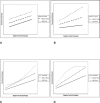The joint effects of life stress and negative social exchanges on emotional distress
- PMID: 17906174
- PMCID: PMC3833820
- DOI: 10.1093/geronb/62.5.s304
The joint effects of life stress and negative social exchanges on emotional distress
Abstract
Objective: Negative social exchanges detract considerably from older adults' emotional health, but little is known about the specific factors that make some older adults more vulnerable than others to such exchanges. This study examined whether stressful life experiences compound the impact of negative social exchanges on emotional distress. We examined both linear and nonlinear models of the joint effects of negative social exchanges and stressful life experiences.
Methods: In-person interviews took place with a representative sample of 916 noninstitutionalized older adults. We examined linear and nonlinear models for three classes of stressful life experiences (relationship losses, disruptive events, and functional impairment).
Result: Regression analyses that included first-order and second-order interaction terms revealed a linear pattern for loss events and functional impairment, and a nonlinear pattern for disruptive events.
Discussion: This study suggests that negative social exchanges and stressful life experiences jointly affect emotional distress, but the particular nature of the joint effects varies by type and level of stressor. Negative social exchanges appear to have more severe effects in the context of some stressors but less severe effects in the context of other stressors.
Figures


References
-
- Aiken, L. S., West, S. G. (1991). Multiple regression: Testing and interpreting interactions Newbury Park, CA: Sage.
-
- Aldwin, C. M. (1990). The elders life stress inventory: Egocentric and nonegocentric stress. In M. A. P. Stephens, J. H. Crowther, S. E. Hobfoll, & D. L. Tennenbaum (Eds.), Stress and coping in later life families (pp. 46–69). Washington, DC: Hemisphere.
-
- Almeida, D. M., Neupert, S. D., Banks, S. R., Serido, J. (2005). Do daily stress processes account for socioeconomic health disparities? Journal of Gerontology: Social Sciences, 60B,S34-S39. - PubMed
-
- Bolger, N., DeLongis, A., Kessler, R. C., Schilling, E. A. (1989). Effects of daily stress on negative mood. Journal of Personality and Social Psychology, 57,808-818. - PubMed
-
- Cohen, J., Cohen, P., West, S. G., Aiken, L. S. (2003). Applied multiple regression/correlation analysis for the behavioral sciences (3rd ed.). Mahwah, NJ: Erlbaum.
MeSH terms
Grants and funding
LinkOut - more resources
Full Text Sources
Medical

